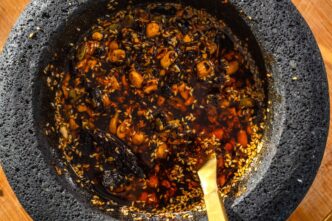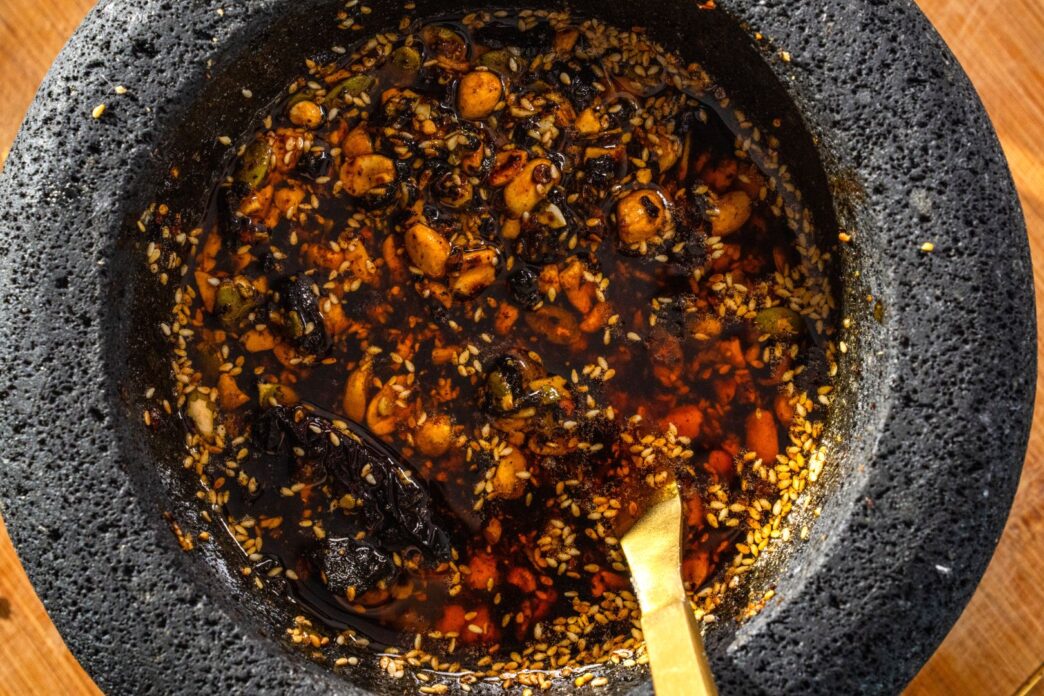Please stop calling everything “chili oil”. This. Is. Salsa. Macha.
Literally translated as “brave sauce,” the name Macha (female of macho) refers to people who felt bold enough to consume and tolerate strong doses of spiciness, which is where the name “Salsa Macha” comes from. Its name also derives from the verb machacar (“to crush”) due to its original preparation method, where the ingredients were crushed in a molcajete.
Salsa Macha is a delicious chili oil traditionally made with a combination of chiles (such as chile morita, chile de árbol, chile guajillo), nuts, spices, and dried fruits. The bright fire red spicy oil is flavorful on its own, and binds the other ingredients together, floating on the surface and leaving a bunch of spices at the bottom to be mixed in.
The use of dried chiles dates back thousands of years to the heart of the Americas, specifically in the region that is now Mexico, considered the birthplace of chiles. Pre-Hispanic civilizations like the Aztecs and Mayans cultivated and dried various chile varieties to preserve them and add a special touch to their recipes. The Mayans used chiles not only as food but also as part of religious rituals, while the Aztecs pioneered the cultivation and use of chiles in sauces and stews.
Once harvested, fresh chiles were sun-dried to preserve them longer, becoming the dried chiles we know today. Interestingly, chile was one of the first domesticated plants in the Americas, becoming an integral part of the pre-Columbian diet. Spanish chronicler Bernardino de Sahagún noted that Aztec markets sold “varieties of dried and fresh chiles” for daily consumption.
The process of transforming fresh chiles into dried ones is an art perfected over centuries. Chiles undergo dehydration, which concentrates their flavors, intensifies their aroma, and allows them to be stored for extended periods.
With the arrival of the Spanish in the Americas in the 16th century, dried chiles began their journey around the world. The conquistadors were fascinated by the intensity and flavor of chiles, bringing them back to Europe, where they quickly became staples in Spanish and Portuguese cuisines.
From there, chiles spread to Asia and Africa, transforming culinary traditions in places like India, where they are now key ingredients in many curries. Thus, dried chiles became a global ingredient, with roots firmly planted in the Americas.
There are hundreds of chiles and dried chiles, but these are the most popular and most likely what you can find at your local market or supermarket:
Guajillo Chile:
Origin: Mainly grown in Zacatecas, Aguascalientes, and Durango.
Flavor profile: Mild with slightly sweet, earthy notes—one of the most versatile chiles in Mexican cuisine.
Uses: Enchilada sauces, moles, and stews.
Ancho Chile (The King of Mole):
Origin: Puebla and central Mexico.
Flavor profile: Sweet with hints of dried fruit and raisins.
Uses: Perfect for moles, adobos, and traditional sauces.
Chipotle Chile (Spicy & Smoky):
Origin: Veracruz and central Mexico.
Flavor profile: Intense, spicy, and smoky.
Uses: Ideal for marinades, stews, and adding a unique kick to sauces.
Pasilla Chile (The Fruity Sibling):
Origin: Oaxaca, Michoacán, and Mexico City.
Flavor profile: Fruity with raisin notes and moderate heat.
Uses: Primarily in sauces, moles, and traditional stuffed recipes.
Chile de Árbol (Small but Mighty):
Origin: Jalisco and Nayarit.
Flavor profile: Very spicy with a slightly bitter edge.
Uses: Perfect for hot sauces, adding fiery heat to broths and soups.
Another great thing about salsa macha is that it’s shelf-stable and doesn’t need refrigeration. Unlike tomato-based salsas, which spoil in a few days, Salsa Macha intensifies in heat and flavor over time, becoming even more delicious.
I find it especially interesting that, like many sauces, Salsa Macha has been adapted by various cultures. From traditional Mexican versions to Chinese and Southeast Asian chili oils, to Hong Kong’s XO sauce and Japan’s rāyu, oil-based condiments are found worldwide.
Salsa Macha’s roots trace back to Orizaba, Veracruz, where the Totonac people ground dried chiles, sesame seeds, and salt into a spicy, oil-free paste. Variations can be found across Mexico. In Oaxaca, toasted grasshoppers (chapulines) are added for crunch. In the state of Colima, it’s known as salsa de chile de árbol, served with the region’s white pozole.
Texas Monthly writer José Ralat suggests that Salsa Macha’s similarities to Asian chili oils may not be coincidental. For centuries after the Spanish conquest, Veracruz (founded by Hernán Cortés in 1519) was a key trading port receiving goods from the East. It’s possible that both Asian chili oil and Salsa Macha emerged from innovations fueled by intercontinental trade. A similar culinary phenomenon occurred in Acapulco, where Spanish galleons brought Japanese influences still present in Mexican cuisine today.
The countless variations of Salsa Macha enhance everything from tacos and fried eggs to roasted veggies and soups. We even love it mixed into simple salad dressings or as a dipping sauce for tortilla chips. And my favorite: pizza. Pizza is Salsa Macha’s Italian best friend. I also save the leftover oil and use it as cooking oil. Besides being just a sauce, it may also offer dietary benefits, like aiding digestion without causing acidity or stomach discomfort. It’s like the capybara of Mexican seasonings.
Now, this edition’s recipe is for a salsa macha base. I like to play around with mine, adding sesame seeds, pumpkin seeds, sometimes dried cranberries (my favorite), peanuts, almonds, playing with the mix of chiles and adding morita and ancho and just one arbol. This is where I say make your own recipe and be happy. Just make sure you don’t add anything with liquid or the shelf life will be compromised and the texture will become some sort of emulsion.
Ingredients
- 30 grams of chile de árbol
- ⅓ cup vegetable oil
- 1 large garlic clove (or 2 small ones)
- Sea salt to taste
Procedure:
- 1. Remove the stems from the chiles and cut them with scissors to remove the seeds. Some people prefer to keep the seeds—that’s a personal choice.
- 2. Heat the oil over medium heat in a large skillet.
- 3. Add the chile de árbol and fry them lightly, stirring quickly to prevent burning. Tilt the pan to separate the chiles from the oil. If doubling the chile quantity, toast them in batches to avoid overcrowding.
- 4. To cool the chiles, place them on paper towels or a strainer until completely cool. Then add them to your blender or food processor with the garlic and a little salt to taste.
- 5. Pulse to process to your liking and place them in a glass jar. Add enough oil to cover and about half an inch extra. Your salsa macha is now ready. It will taste better tomorrow, and even better the day after and so on. This is a salsa that just keeps getting better.
I am always happy to hear from you at al**********@***********te.com
Thanks for reading!



